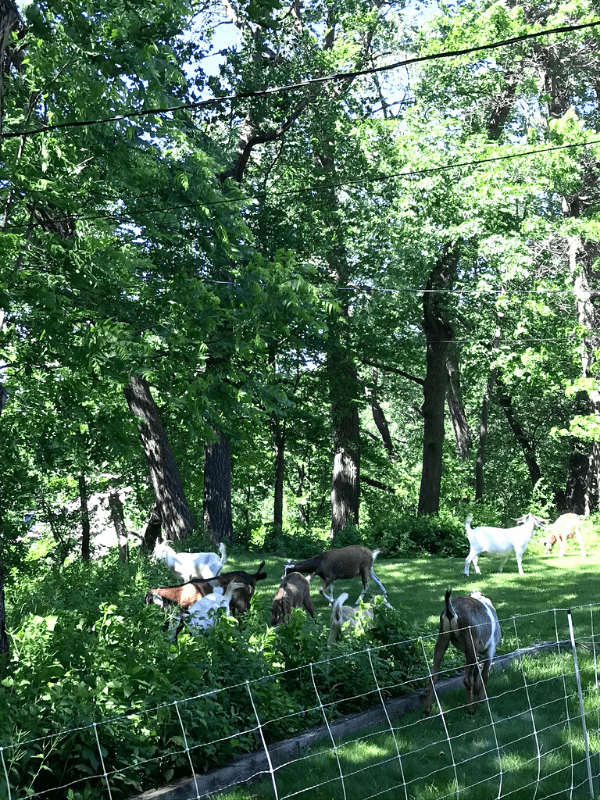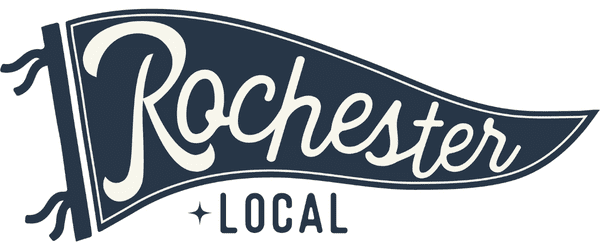
We totes ma goats had a weed problem.
The Back Story
We moved into our home in NE Rochester in the fall of 2019, but it wasn’t until this spring that we fully realized the overgrown weed situation at the back of our property just beyond our backyard. We’re talking waist-high invasive plants…the kind you definitely DON’T want.
We bought our home from the most wonderful, kindest, most delightful couple that had spent the last 53 years calling this house their home. We wanted to take care of this home and care for it in the same way they did. In this way, we would honor the history of the home and the memories made here while creating our own. We knew we wanted to restore the back part of the yard to usable space by planting native grasses, ferns, and pollinator-friendly plants for our family to enjoy for many years to come. But how do we do that? Invasive weeds are…invasive! And hard to get rid of. We didn’t love the idea of multiple applications of herbicide (although we did know that we would need to do so in order to fully eradicate the invasive weed species).
Getting Started
We had heard about goats being used for weed control before but weren’t sure if our project would be the type of project that goats usually tackle, especially as we live in a residential neighborhood. I called up a local company (no longer in business but GoatDispatch is!) and then proceeded to consume every piece of information on the internet about using goats for weed control. I was hooked after reading all of the information out there!
Prescribed Goat Grazing
If you’re like me, you probably have never heard the term prescribed goat grazing before. This type of goat grazing is closely monitored and controlled to ensure goats are eliminating weeds and vegetation in the intended spots only. It also speaks to the nature of the service: a prescription for how goats can restore the land they are working on. Sometimes this means the goats will visit once, and sometimes it means they will come back multiple times over the course of a few years.
Prescribed goat grazing is for projects of all shapes and sizes: from small backyard projects like mine to larger ongoing projects on many acres of land. Goat grazing companies are incredibly knowledgeable, passionate, and clearly interested in helping people achieve success with their projects. After hearing about our end goals, assessing the vegetation, and taking some measurements, we were informed that not only would this be a great project for goats, but it would only take FOUR days! Sign us up!
I set about asking my neighbors if they were okay with us having goats in the backyard for a few days. One of our neighbors was so intrigued that he decided to join right in with us!
Why did invasive weeds grow in the first place?
In my research to find out why goats were so great in helping eradicate weeds, I learned so much about the environment, natural habitat, native species, and more. I was fascinated by what I was reading and wondered why I didn’t have a more comprehensive knowledge base prior to this.
In any environment, there are plants that grow that are specifically suited for the type of soil, environment, climate, animal use, etc. When natural habitat areas are changed by construction, natural disasters, or otherwise disturbed, the cycle needed to keep the equilibrium of plants and animals going is broken. Animals are necessary in any area where there is vegetation. The animals eat the vegetation, and then their nitrogen-rich waste is deposited back into the ground. Native plant species thrive in a nitrogen-rich environment. When animals move out of a habitat or environment, the soil becomes less nutrient-rich in nitrogen. This allows fast-growing invasive species to move in and engulf the more fragile growing systems of native plant species.
You might be familiar with some of the more common invasive species in Minnesota:
- Buckthorn
- Garlic Mustard
- Creeping Charlie
- Queen Anne’s Lace
- Wild Parsnip
- Leafy spurge
- Giant hogweed, and more
Goat Day!
Everyone was very excited the day the goats arrived. The evening before, the solar-powered electric fence was installed that would keep the goats in the specifically-outlined area. I was reassured several times that the goats wold respect the fence. And they did!
They pulled the trailer up to the electric fence corridor they had put up in our yard, swung open the trailer door, and lead the ten goats that would be our visitors for the next 4 days to their new feeding grounds. Our kids were ecstatic!
The goats immediately went to town eating all sorts of things. I have to imagine they believed they were at some sort of magical vegetation goat buffet. One of the most poignant moments was when I looked over and watched a goat eat a 3′ wide burdock weed to the plant in about 2 minutes flat. I couldn’t believe it!

Each day, several things were checked including the goats’ water levels, the fence, and their progress on the weeds. I found out that the goats didn’t need much water as they absorbed so much from the plants they were eating.
At the end of 4 days, the goats and the fence were removed, loaded up, and sent home. We could hardly believe the transformation in such a short amount of time.
Why are goats the answer?
Goats are an incredible member of the bovine family. They are renowned and completely notorious for eating anything and everything. Additionally, they are highly curious creatures. While goats really do love to eat a lot, their preference is for the tall, leafy, and even woody vegetation listed above. Goats are ruminants, meaning their stomachs have four chambers, and contain special enzymes that humans and other mammals lack that allow for the breakdown of cellulose, the main carbohydrate in plants. For this reason, goats receive a lot of energy from the nutrients in plants that other animals tend to ignore. Additionally, their digestive tracts are so strong, that any seed that might be strong enough to make it to the other side of a goat is rarely viable for growth.
Additionally, goats’ waste is dense in nitrogen. When they graze over an area, they deposit their waste and their unique cloven hooves push it into the ground without trampling an area. Goat grazing ensures a rich environment to reintroduce native plants back into the habitat.
Before & After
Restoration
The goats were exactly the springboard we needed to jump-start our restoration project. We have gone back through after the goats finished and kicked out rotted buckthorn stumps and trimmed back any new growth. After some additional preparation and working the ground, we will be able to spread seeds for native Minnesotan grasses, ferns, and forbs (flowering plants). This is the very beginning of the work we will do over the next few years to restore that land. Our hope is that it will be a beautiful space that invites native flora and fauna back, and maybe even make their home.









